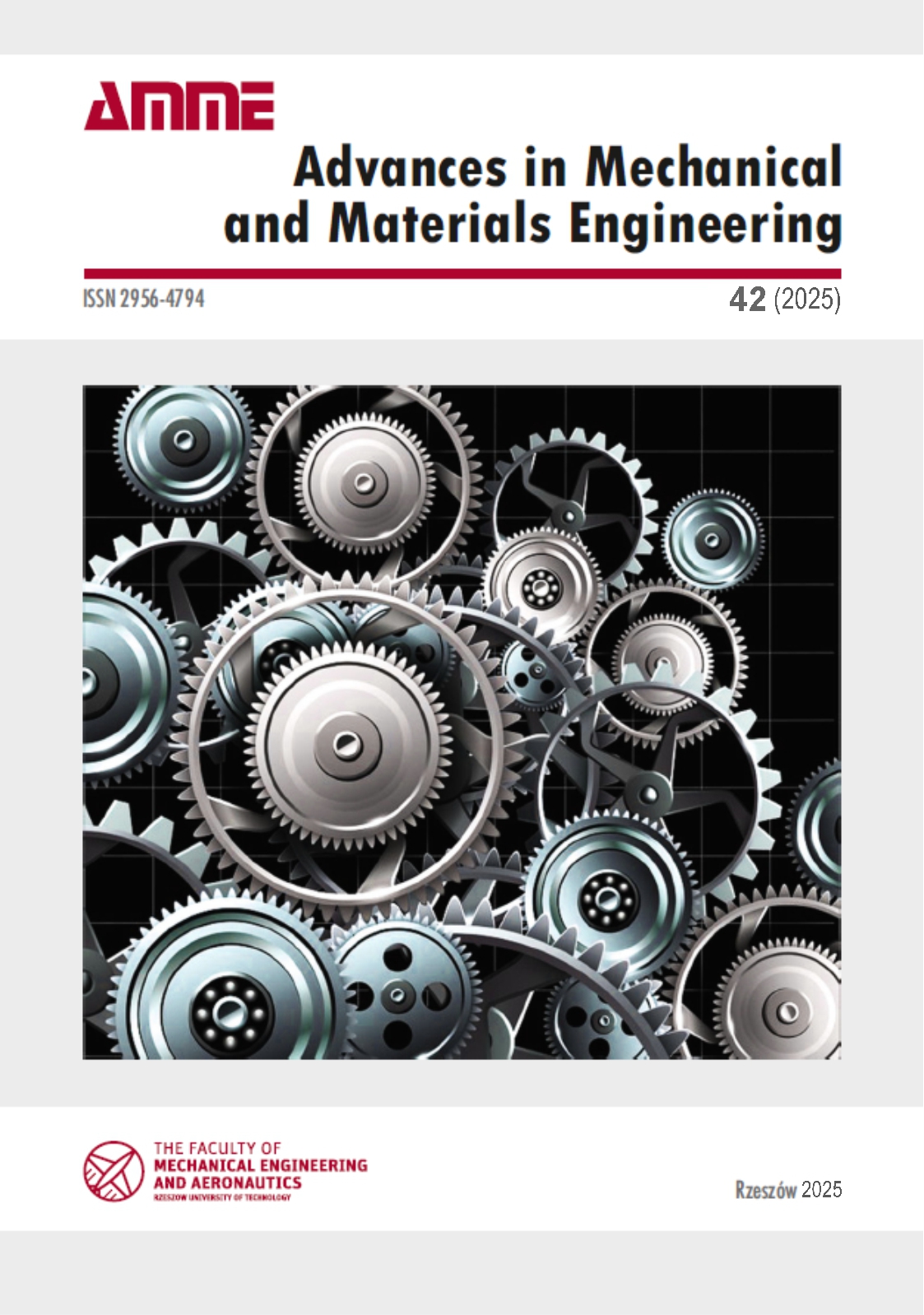Abstract
Elastomeric materials are used in the methods of plastic forming of sheets made of difficult-to-deform materials. This article presents the results of strength tests of selected elastomeric materials intended for sheet metal stamping. Polyurethane elastomers with a hardness of 50, 70 and 90 Sh A were used for the tests. The behaviour of the materials was determined in a simple compression test, a volumetric compression test and a uniaxial tensile test. In the case of the simple compression test, the values of the maximum force for a set punch travel of 3 mm were 1400 N, 2250 N and 4950 N for samples with hardnesses of 50, 70 and 90 Sh A, respectively. In a volumetric compression test, the maximum compressive force for a sample with a hardness of 90 Sh A was more than twice lower than the compressive force of samples with a hardness of 50 and 70 Sh A. In the tensile tests, the values of the obtained strains ranged from about 750% for the sample with a hardness of 50 Sh A to about 1350% for the sample with a hardness of 90 Sh A.
References
Afteni, C., Costin, G., Iabob, I., Păunoiu, V., & Virgil T. (2018). A review on sheet metal rubber-pad forming. Annals of ”Dunarea de Jos” University of Galati, Fascicle V, Technologies in Machine Building, 36, 49-54. https://doi.org/10.35219/tmb.2018.1.07
Alarifi, I. M. (2023). A comprehensive review on advancements of elastomers for engineering applications. Advanced Industrial and Engineering Polymer Research, 6(4), 451-464. https://doi.org/10.1016/j.aiepr.2023.05.001
Al-Qureshi, H. A. (1972). Analytical investigation of ram movement in piercing operation with rubber pads. International Journal of Machine Tool Design and Research, 12(3), 229-248. https://doi.org/10.1016/0020-7357(72)90023-6
American Society for Testing and Materials. (2018). Standard Test Methods for Rubber Properties in Compression. (ASTM Standard No. D575-91). https://www.astm.org/d0575-91r18.html
Aravind, U., Gopalakrishnan, C.K., Uday, C., & Venugopal, P. (2017). The effect of using rubber for applying counter force in fine blanking of AISI 304 Stainless Steel. Procedia Engineering, 207, 1523-1527. https://doi.org/10.1016/j.proeng.2017.10.1072
Bednarz, J., & Targosz, J. (2013). The examination of elastomeric materials used in vibroisolation and soundproof isolation systems in structural engineering. Journal of Kones, 20(4), 23-30.
Benisa, M., Babic, B., Grbovic, A., & Stefanovic, Z. (2012). Computer-aided modeling of the rubber-pad forming process. Materials and Technology, 46(5), 503-510.
Flamm, M., Spreckels, J., Steinweger, T., & Weltin, U. (2011). Effect of very high loads on fatigue life of NR elastomer materials. International Journal of Fatigue, 33(9), 1189-1198. https://doi.org/10.1016/j.ijfatigue.2011.03.008
Gehling, T., Schieppati, J., Balasooriya, W., Kerchbaumer, R.C., & Pinter, G. (2023). Fatigue behavior of elastomeric components: A review of the key factors of rubber formulation, manufacturing, and service conditions. Polymer Reviews, 63(3), 763-804. https://doi.org/10.1080/15583724.2023.2166955
International Organization for Standardization. (2024). Rubber, vulcanized or thermoplastic — Determination of tensile stress-strain properties. (ISO Standard No. 37:2024). https://www.iso.org/standard/86892.html
Ju, Y.H.; & Hu, J.W. (2021). Experimental study on the behavior of polyurethane springs for compression members. Applied Sciences, 11(21), Article 10223. https://doi.org/10.3390/app112110223
Kumar, A., Kumar, S., & Yadav, D. R. (2014). Review of rubber based sheet hydro-forming processes. Proceedings of the 5th International & 26th All India Manufacturing Technology, Design and Research Conference (pp. 1-5).
Perduta, A., & Putanowicz, R. (2015). Comparision of elastomer modelling in various FEM packages. Procedia Engineering, 108, 510-517. https://doi.org/10.1016/j.proeng.2015.06.113
Quadrini, F., Santo, L., Squeo, E. (2010). Flexible forming of thin aluminum alloy sheets. International Journal of Modern Manufacturing Technologies, 2(1), 79-84.
Ramezani, M., Mohd, Z., Ripin, Z. M., & Ahmad, R. (2010). Sheet metal forming with the aid of flexible punch, numerical approach and experimental validation. CIRP Journal of Manufacturing Science and Technology, 3(3), 196-203. https://doi.org/10.1016/j.cirpj.2010.11.002
Ramezani, M., Ripin, Z. M, & Ahmad, R. (2009). Computer aided modeling of friction in rubber-pad forming proces, Journal of Materials Processing Technology, 209(10), 4925-4934. https://doi.org/10.1016/j.jmatprotec.2009.01.015
Sayar, M. A., Gerdooei, M., Eipakchi, H., & Nosrati, H. G. (2025). Rubber mandrel and internal pressure effects on thin-walled tube bending: A comparative study. International Journal of Advanced Manufacturing Technology, 136, 3197–3213. https://doi.org/10.1007/s00170-025-15019-7
Spontak, R. J., & Patel, N. P. (2000). Thermoplastic elastomers: fundamentals and applications. Current Opinion in Colloid & Interface Science, 5(5-6), 333-340. https://doi.org/10.1016/S1359-0294(00)00070-4
Swinarew, B. (2014). Poliuretany - nowoczesne wszechstronne materiały. Część I - charakterystyka ogólna. Przetwórstwo Tworzyw, 3, 252-259.
Thiruvarudchelvan, S. (1993). Elastomers in metal forming - A review. Journal of Materials Processing Technology, 39(1-2), 55-82. https://doi.org/10.1016/0924-0136(93)90008-T
Thiruvarudchelvan, S. (2002). The potential role of flexible tools in metal forming. Journal of Materials Processing Technology, 122(2-3), 293-300. https://doi.org/10.1016/S0924-0136(02)00077-8
Zaragoza, V. G., Strano, M., Iorio, L., & Monno, M. (2019). Sheet metal bending with flexible tools. Procedia Manufacturing, 29, 232-239. https://doi.org/10.1016/j.promfg.2019.02.131
Ziobro, J. (2013). Wieloosiowa analiza naprężeń i odkształceń gumy na bazie kauczuku naturalnego. Zeszyty Naukowe Politechniki Rzeszowskiej, Mechanika, 288(85), 197-206. http://dx.doi.org/10.7862/rm.2013.19


